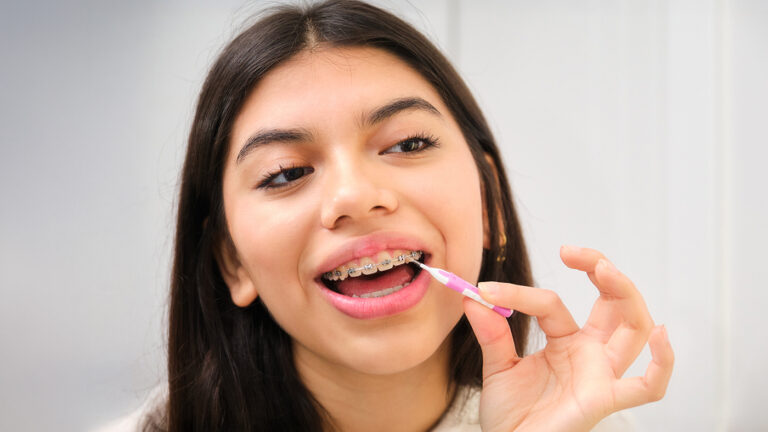Broken brackets and pokey wires happen more often than you’d think and almost always happen at the most inconvenient times (we’re looking at you, road trip). If your child’s bracket pops loose, or a wire breaks or pops out of the bracket, it can be a stressful and uncomfortable experience. However, the good news is that most minor orthodontic issues can be easily managed at home until you can visit the office.
A little orthodontic wax can be your best friend until you can get in to see us, and clipping a rogue wire with clean nail clippers might just save the day. In this guide, we’ll walk you through what to do when a bracket breaks or a wire comes loose, so you can handle the situation like a pro and keep your child comfortable through it all.
How Brace Brackets and Wires Work
When everything is working as designed, the braces have a low profile over the teeth and don’t interfere with normal chewing, swallowing, or speaking. Aside from temporary soreness, the most common cause of pain during orthodontic treatment is when something breaks. The good news is that it doesn’t happen very often, especially with some basic precautions in place.
Orthodontic adhesives are specially made to bond the metal brackets to the enamel surface of the teeth. The dental glue is strong enough to hold the brackets in place in the long term but weak enough to come off without too much hassle at the end of the treatment period. Most of the time, it works out just fine, but sometimes brackets can break loose before they’re supposed to. When that happens, the broken bracket or wire can rub or poke against the cheeks, lips, or gums, creating discomfort, irritation, or even sores.
Common Causes of Broken Brackets and Loose Wires
The most common causes of breakage are:
- Eating hard or sticky foods (such as popcorn, nuts, ice, or hard candies)
- Brushing too hard
- Grinding or clenching teeth
- Chewing on hard non-food items (like pens or pencils)
- Blunt force or trauma to the mouth
The best way to help prevent broken brackets or wires is to avoid foods that are risky to the teeth and to protect the mouth when playing sports or engaging in other high-impact activities.
What to Do If a Bracket or Wire Breaks
First things first, don’t panic. Braces work by applying pressure to multiple teeth simultaneously over an extended period of time. A single, disconnected bracket is unlikely to have a significant impact on your child’s treatment, especially if it’s addressed relatively soon.
If a damaged bracket or wire isn’t causing any pain or injury, you might even be able to wait until your next scheduled orthodontic visit. The first step is to call your orthodontist, who can provide proper guidance and schedule an appointment to correct the issue. In the meantime, here’s how you can handle some common breakages at home.
Step 1: Use Orthodontic Wax for Comfort
Regardless of how quickly you can get into the orthodontist, a little bit of wax can help protect your child while you wait. Roll a pea-sized amount of orthodontic wax into a ball and press it over the broken bracket or wire, then flatten it until you have a smooth surface. It isn’t a permanent solution, but it can help prevent scrapes, cuts, and pokes until you can address the issue.
Step 2: Gently Adjust a Loose Bracket or Wire (If Needed)
Sometimes you can make minor adjustments at home that can hold you over until you can get a permanent fix. If a loose bracket is in an unfavorable position, you can use tweezers to slide it back into place. The same goes for a broken wire poking into the cheeks or gums.
Nail clippers can also be used to clip a broken archwire so it doesn’t stick out so much. Use a tissue to catch the snipped bits so they don’t get swallowed. Make sure to clean and sterilize any tools before placing them in the mouth.
Step 3: Soothe Cuts, Scrapes, and Sores
With all that metal in the mouth, it’s not uncommon to get a sore or two every now and then. Fortunately, mouth sores usually heal pretty quickly without any intervention. Use wax to create a protective barrier and help prevent further injury. You can also use antiseptic or antibacterial mouthwash, or saltwater rinses, to keep sores clean and support healing.
Step 4: Keep Brushing and Flossing Carefully
You may need to take extra care when cleaning around the affected area, but it’s important to continue brushing and flossing, even if there are broken brackets or wires. Keeping the area clean helps reduce irritation and the risk of infection while you wait for a repair.
Step 5: Schedule a Repair Appointment
At-home fixes can hold you over for a few days, but broken brackets and wires will require permanent repair. The good news is that repair appointments are usually pretty quick. Often, the archwire is removed and the broken components are cleaned. The tooth surface is then prepared, the bracket or brackets are rebonded, and the wire is replaced. The entire process typically takes around 10 minutes.
When Is a Broken Bracket or Loose Wire an Emergency?
Most broken brackets and loose wires are inconvenient rather than urgent. However, you should contact your orthodontist right away or seek urgent care if:
- A wire is embedded in the cheek, tongue, or gums
- There is significant bleeding that doesn’t stop
- Your child has trouble swallowing or closing their mouth
- There is a suspected injury to the teeth or jaw after a fall or blow to the face
- Pain is severe and not improving with simple home measures
When in doubt, call your orthodontist’s office and describe what you’re seeing. They can help you decide whether your child needs to be seen immediately or can safely wait for the next available appointment.
How to Prevent Broken Brackets and Wires
While not every mishap can be avoided, a few simple habits can reduce the risk of broken brackets and wires:
- Avoid hard or sticky foods like popcorn, nuts, ice, caramel, and hard candies
- Don’t chew on pens, pencils, fingernails, or other hard objects
- Wear a mouthguard during sports or other high-impact activities
- Brush and floss gently around brackets and wires
- Follow any food and care guidelines provided by your orthodontic team
A Quick Reminder for Kids (and Parents)
If your child accidentally detaches a bracket or breaks a wire, remember that it’s not the end of the world. These things are a common part of having braces, usually have minimal impact on overall treatment when addressed, and are often easy to fix.
Encourage your child to be careful with what they eat and how they treat their braces, and remember that your orthodontic and pediatric care teams are here to help if and when a broken bracket or loose wire occurs.




